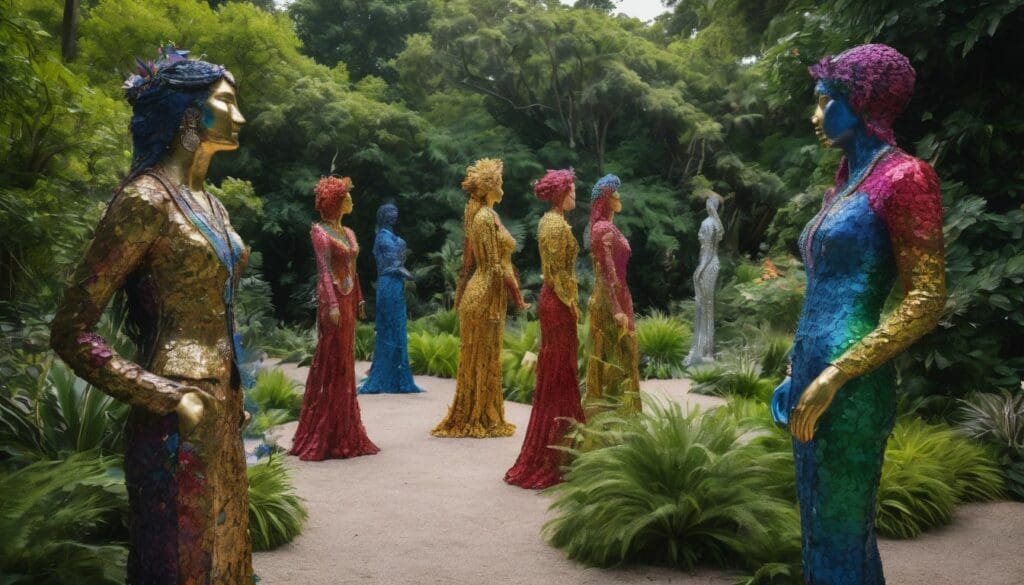Understanding how to protect our planet can often feel overwhelming. However, integrating art and design into sustainability education is proving to be a game-changer. This article will guide you through the vibrant ways that art is not just beautifying our world but also saving it.
Let’s paint a greener future together!
Key Takeaways
- Art and design in education spotlight environmental issues and inspire learners to act for sustainability.
- Creative projects connect art, science, and language arts, making learning about the planet’s health engaging.
- By thinking critically through artistic endeavors, students develop a sense of responsibility towards the environment.
- Sustainability themes in art can drive community conversations and lead to eco-friendly changes.
- Learners merge aesthetics with problem – solving to communicate complex sustainability concepts effectively.
The Power of Art and Design in Sustainability Education
Art and design have the power to empower learners with knowledge, skills, and values, cultivating environmental appreciation and stewardship. They provide a platform for discussing sustainability issues and inspiring action and change through artistic expression.
Empowering learners with knowledge, skills, and values through art
Art education isn’t just about creating; it’s a powerful tool for shaping the minds that will build our future. By weaving sustainable development themes into art projects, teachers light sparks of ecological awareness in students.
They learn to value renewable resources and understand the impact of ethical consumption through hands-on experiences with eco-friendly practices. Creative tasks challenge them to think critically about their role in preserving the planet while fostering a deep appreciation for environmental stewardship.
Learners apply these lessons by designing solutions that reflect green design principles. They take away not only an enhanced aesthetic sensitivity but also a sense of personal responsibility towards conservation and sustainability.
This holistic approach equips young minds with the courage to express their ideas and inspires artistic activism aimed at safeguarding our world. Moving forward, cultivating environmental appreciation becomes as crucial as mastering brush strokes or sculpting techniques.
Cultivating environmental appreciation and stewardship
By fostering an understanding of sustainability and environmental stewardship in art and design education, individuals are inspired to appreciate the natural world and consider their impact on it.
Through creative exploration, learners develop a deep sense of respect for the environment whilst cultivating an innate connection with nature through artistic expression. Engaging with eco-friendly practices across various art forms encourages students to think critically about conservation, urging them to actively contribute towards sustainable living through their own creative pursuits.
Encouraging environmentally conscious decision-making enables students not only to understand but also embody the significance of preserving our planet. This holistic approach immerses learners in a culture that cherishes ecological balance, instilling values of responsibility and care for our surroundings as they express themselves creatively.
The Intersection of Sustainable Development, Education, and Art
Art and culture play a crucial role in contributing to sustainable development by promoting awareness, understanding, and appreciation of environmental issues. By incorporating art into sustainability education, learners can develop a deeper connection to the environment and understand their role in creating a more sustainable future.
How art and culture can contribute to sustainable development
Art and culture play a crucial role in promoting sustainable development by raising awareness and fostering a sense of environmental responsibility. Through various forms of artistic expression, individuals can be inspired to appreciate nature, advocate for conservation, and embrace eco-friendly practices.
Cultural education, including art, crafts, and design, provides a platform for discussions on sustainability issues that can lead to meaningful action and change. By integrating art into the dialogue on environmental sustainability, communities are encouraged to embrace innovative solutions for a more sustainable future.
When considering the interconnectedness of art and culture with sustainable development goals, it becomes evident that creative expression has the potential to drive positive social and environmental impact.
Whether through visual arts or performance-based mediums, art serves as a catalyst for inspiring eco-conscious behaviours while nurturing an appreciation for our planet’s natural beauty.
The role of art in promoting sustainable living
Art plays a crucial role in promoting sustainable living by raising awareness and inspiring action. Through various artistic mediums such as visual art, music, and performance, important environmental issues can be highlighted to evoke emotional responses.
Art has the power to engage people on a deeper level, encouraging them to reflect on their impact on the environment and consider more eco-friendly practices. Additionally, art can serve as a platform for sparking meaningful conversations about sustainability and prompting positive change towards a greener future.
Creative expression through art can influence attitudes and behaviors toward sustainability in profound ways. By showcasing nature’s beauty or depicting the consequences of environmental degradation, artists encourage individuals to embrace ecologically responsible habits and support conservation efforts.
Incorporating Sustainability into Art and Design Education
Incorporating sustainability into art and design education is crucial for fostering aesthetic sensitivity and critical thinking, while also connecting art, science, and language arts in STEM units.
By integrating eco-friendly practices into artistic expression, learners can gain a deeper understanding of sustainability and its importance in the world today.
The importance of aesthetic sensitivity and critical thinking
Aesthetic sensitivity is vital in fostering an appreciation for the beauty of nature and the need for sustainability. Encouraging learners to critically analyse visual elements within art and design helps develop a deeper understanding of environmental issues.
This heightened awareness can inspire creative solutions that align with eco-friendly practices, thus contributing to a sustainable future.
Cultivating critical thinking skills within art and design education empowers individuals to approach environmental challenges from diverse perspectives. It allows them to explore innovative ways to communicate complex sustainability concepts through artistic expression.
Connecting art, science, and language arts in STEM units
- Utilising art to explore scientific concepts such as environmental cycles and ecosystems, creating a visual understanding of these crucial systems.
- Incorporating language arts by using art as a stimulus for creative writing, where students express their thoughts on environmental issues through storytelling or poetry.
- Engaging in hands – on activities that merge artistic expression with scientific experimentation, fostering an appreciation for both disciplines.
- Encouraging interdisciplinary collaboration between art, science, and language arts to address real-world environmental challenges, promoting problem-solving skills and critical thinking.
- Fostering innovative thinking by exploring how different forms of art can communicate scientific principles and environmental messages effectively.
The Transformative Power of Art and Design
Using art as a platform for discussing sustainability issues and inspiring action and change through artistic expression.
Using art as a platform for discussing sustainability issues
Art serves as a powerful platform for engaging individuals in discussions about sustainability. Through art, complex environmental issues can be communicated in compelling and accessible ways.
Artists have the ability to harness visual and emotional elements to shed light on ecological challenges, encouraging viewers to reflect on their impact on the planet. By integrating sustainable themes into their work, artists prompt critical thinking and spur conversations about ecofriendly practices.
This approach empowers individuals to consider how they can contribute positively towards a more sustainable future.
Art helps raise awareness of sustainability issues, fostering dialogue and inspiring positive action within communities. Creative expressions such as sculptures, paintings, and installations can effectively convey messages about conservation and environmental stewardship.
Inspiring action and change through artistic expression
Art serves as a powerful tool for inspiring action and change in environmental conservation. Through art and design, individuals can express their concerns about sustainability issues in creative and impactful ways.
This artistic expression has the potential to raise awareness, provoke critical thinking, and mobilise communities towards sustainable practices. By integrating themes of environmental consciousness into visual arts, crafts, and design projects, individuals can use their creativity to advocate for positive change on a local or global scale.
Engaging with art that promotes sustainability can ignite passion and motivation within communities to take meaningful action towards protecting the environment. Visual representations of ecological challenges foster empathy among viewers, compelling them to reconsider their attitudes and behaviour towards nature.
Conclusion: Teaching Sustainability through Art and Design – A Path towards a Sustainable Future
In conclusion, incorporating sustainability into art and design education can ignite a passion for environmental stewardship. Art has the power to inspire action and change through creative expression.
By harnessing the transformative potential of art, we pave the way towards a sustainable future. Through this approach, learners are empowered with the knowledge and skills to contribute to a more sustainable world.
FAQs
1. How can art education promote sustainability?
Art education encourages creativity and innovation, allowing students to use arts and crafts to explore environmental themes and learn about the importance of design for sustainability.
2. Why should we integrate environmental education into art and design classes?
Including environmental education in art and design helps raise awareness among students about the relationship between art, environment, and sustainable living practices.
3. Can teaching sustainability through art be a part of STEM education?
Yes, teaching sustainability through creative subjects like art complements STEM education by adding elements of critical thinking on eco-friendly designs and solutions.
4. What benefits do students gain from learning about sustainability in their arts courses?
Students engage with real-world issues, develop problem-solving skills, and enhance their understanding of the necessity for sustainable practices while interacting with various materials during their art-making process.





